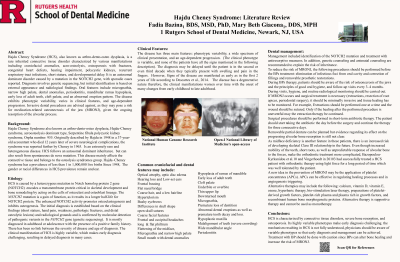Syndromes/Craniofacial Anomalies
402 - Hajdu Cheney Syndrome: Literature Review

- FB
Fadia S. Bazina, BDS,MSD,PhD
Resident
Rutgers School of Dental Medicine, Newark, NJ
Rutgers School of Dental Medicine
West Orange, New Jersey, United States - MG
Mary Beth Giacona, DDS
Rutgers School of Dental Medicine, Newark, NJ
- MG
Mary Giacona, DMD, MPH
Rutgers School of Dental Medicine, Newark, NJ
Newark, New Jersey, United States - MM
Madhu Mohan, DMD
Rutgers School of Dental Medicine, Newark, NJ
Newark, New Jersey, United States
Presenting Author(s)
Co-Author(s)
Research Mentor(s)
Program Director(s)
Hajdu Cheney Syndrome (HCS), also known as arthro-dento-osteo dysplasia, is a rare inherited connective tissue disorder characterized by various manifestations including craniofacial anomalies, acro-osteolysis, osteoporosis with fractures, congenital heart defects, hearing impairment, polycystic kidneys, recurrent respiratory tract infections, short stature, and developmental delay. It is an autosomal dominant disorder caused by a mutation in the NOTCH2 gene, with sporadic cases reported. Diagnosis involves genetic sequencing, but initial identification is based on external appearance and radiological findings. Oral features include micrognathia, narrow high palate, dental anomalies, periodontitis, mandibular ramus hypoplasia, early loss of adult teeth, cleft palate, and an abnormal eruption pattern. The disease exhibits phenotypic variability, varies in clinical features, and age-dependent progression. Invasive dental procedures are advised against, as they may pose a risk for medication-related osteonecrosis of the jaw (MRONJ), given the ongoing resorption of the alveolar process.
Identify Supporting Agency and Grant Number:

.jpg)